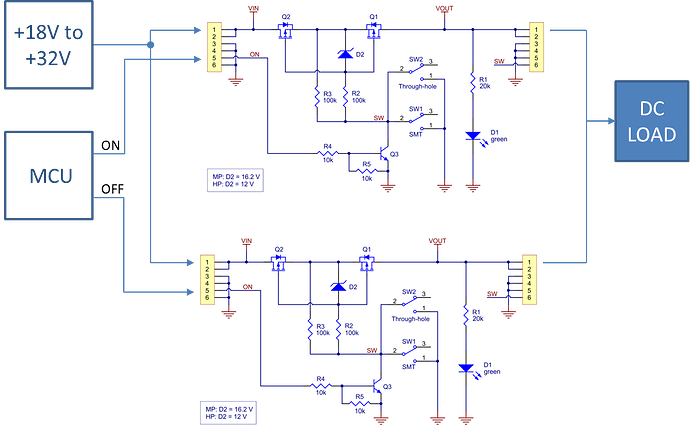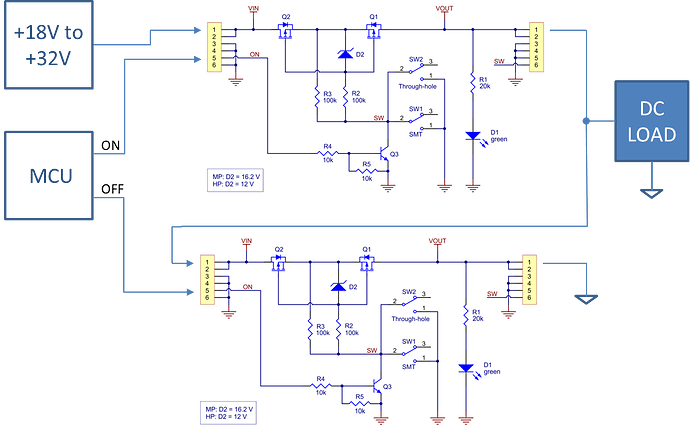I need to create a power interrupter for a DC load. I was thinking of using two of these to create sort of a half-bridge for that purpose. Just wanted to see if you had any experience using these modules for that sort of thing. Looking to switch on and off a mostly resistive (and capacitive) load at +28V / 1.5A.
Hi.
Our Big MOSFET Slide Switches are designed to switch on and off power to a load with just a single switch. Could you post a diagram of your proposed setup and some more details about your application?
-Claire
Claire, thank you for the prompt response and sorry for the delay. Attached is the concept of what I had in mind. I am pretty sure this should be ok as long as I can guarantee the either “leg” switches off before the other one switches on.
It is still unclear to me from your diagram what you are trying to switch between. Is the idea to drive current through the load in one direction and then the other direction? It might be helpful if you specify what your load is and include its connections in your diagram.
-Claire
What I intend to do is switch the power supply to a piece of electronics on/off over an extended period. I could easily use a relay but it rings and does not deplete the energy of the piece of electronics and therefore is not a clean on/off power cycle. I could use a high-side FET (or low-side) which would not ring but it would still not deplete the energy when switching off. A high-side and low-side (i.e. a type of h-bridge) would do a clean on/off switch. I am looking at an inexpensive power cycler. The load itself can be any type of dc electronic equipment that is normally powered by +28V and which does not draw more than two amps.I’ll go ahead and try it once I get some free time at work to wire it together and code an MCU to interface to it and provide me programmable switching on/off times.
To me, assuming the load returns current to the shared 2815 ground, your circuit is just powering the load through the upper 2815 when the MCU asserts ON, and through the lower 2815 when it asserts OFF. Am I wrong? Additionally, I’m wondering if what you are trying to create is really a half H-bridge, i.e. something that can either freewheel or sink current when it’s off. I don’t think that’s possible with these particular switches though because they are reverse-voltage protected and require a minimum input voltage.
If the outputs of both switches are connected to the same place on your load, as jlo said, one switch will power the load while the ON signal is high and the other switch will power the load while the OFF signal is high. jlo is also correct that these power switches cannot be used as a low-side switch (to connect and disconnect ground). If you are having problems with the load not discharging quickly enough when power is removed, you might look into adding a bleed resistor or something similar.
-Claire
Wow, what a dumb move on my part. You both spotted my mistake on the drawing and twice I missed it. I re-attached the corrected picture of what I meant (very similar to what @jlo mentioned on his post. The bleeder resistor is not enough (too slow), but let me see what I can work out. The high-side part is great as it is way cleaner than a relay. I just need a way to drain the power once the high-side condition is OFF.
But the low-side application is what I’m suspecting is not possible with the 2815. Due to it’s minimum Vin requirement, I’m not sure what it will do once the DC load drive voltage drops below min Vin. I think it will just stop conducting. Also, it can’t free wheel because it’s reverse-voltage protected, which I assume means current can’t flow from Vout to Vin from ground (but maybe not).
That was what my original (and unclear) question was around. I’ll think a bit more about that. Thanks (to both).
jlo is right. As I mentioned in my previous post, these power switches are not appropriate for use as a low-side switch and will not provide a reverse path for current when freewheeling. Unfortunately, I do not have any other suggestions.
-Claire


